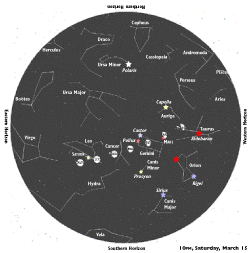Winter’s Last Go-Round
The Great Winter Circle still lights up the evening sky
The waxing moon brightens our night skies and is visible from sunset well into the early morning. On the 14th, look for the half-full moon close to red-orange Mars. A few nights later, on the 18th, the moon passes a couple degrees past the blue-white star Regulus, the heart of Leo the lion, with Saturn a few degrees farther to the east. On the 19th, the moon again lines up with Saturn and Regulus, this time shifting to the east of the two.
Spring may be in the air, and this is the last week of astronomical winter, but sunset still reveals the lingering stars of winter. Containing seven of the 23 brightest stars, the Great Winter Circle also entails several of the most familiar constellations.
First look for the familiar shape of Orion the hunter, which hangs high in the south at sunset, around 7:15. The blue star marking his southwestern-most corner is the blue-hued Rigel.
From Rigel, look to the southeast for blue Sirius, the brightest of all stars. Dubbed the Dog Star, Sirius was the larger of Orion’s two hunting dogs and anchors the constellation Canis Major. Shift your gaze to the northeast to find the little dog, yellow Procyon, of Canis Minor.
Next, look to the north for the constellation Gemini, whose twin stars Pollux and Castor glow red-orange and blue-white respectively.
Now extend a line from Pollux and Castor to yellow Capella in the constellation Auriga, the charioteer. Finally, turn your gaze to the west to the red-giant Aldebaran, the eye of Taurus the bull, which closes the circle. Another red-giant, Betelgeuse, the 10th brightest star, shines in the middle of the circle marking Orion’s shoulder.
Tidelog®
Illustration: © Copyright 1925 M.C. Escher/Cordon Art-Baarn-Holland; Graphics: © Copyright 2007 Pacific Publishers. Reprinted by permission from the Tidelog graphic almanac. Bound copies of the annual Tidelog for Chesapeake Bay are $14.95 ppd. from Pacific Publishers, Box 480, Bolinas, CA 94924. Phone 415-868-2909. Weather affects tides. This information is believed to be reliable but no guarantee of accuracy is made by Bay Weekly or Pacific Publishers. The actual layout of Tidelog differs from that used in Bay Weekly. Tidelog graphics are repositioned to reflect Bay Weekly’s distribution cycle.Tides are based on National Oceanic and Atmospheric Administration and are positioned to coincide with high and low tides of Tidelog.
